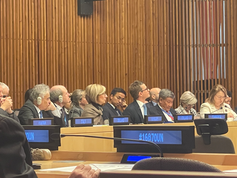U.S. Naval Buildup in Caribbean Raises Questions Over Motives Toward Venezuela
- Olga Nesterova

- Aug 30
- 2 min read

A major deployment of U.S. naval forces in the Southern Caribbean has sparked debate over whether Washington is targeting drug cartels, as the Trump administration claims, or pressuring Venezuela’s government under President Nicolás Maduro.
Seven U.S. warships and a nuclear-powered fast attack submarine, carrying more than 4,500 sailors and marines, have moved into the region.
The White House says the buildup is aimed at dismantling drug trafficking organizations and criminal cartels.
“The mission is to combat and dismantle drug trafficking organizations, criminal cartels and these foreign terrorist organizations in our hemisphere,” said Stephen Miller, deputy White House chief of staff.
But analysts question the logic. Most maritime cocaine trafficking occurs in the Pacific, not the Atlantic, while much of the Caribbean flow involves clandestine flights. A 2023 United Nations report found that 74% of cocaine northbound from South America travels via the Pacific.
Venezuelan officials insist the military presence is a veiled threat against Caracas. Maduro, Interior Minister Diosdado Cabello, and Ambassador to the UN Samuel Moncada have accused Washington of preparing for intervention. “We are not drug traffickers, we are noble and hard-working people,” Defense Minister Vladimir Padrino said.
The United States has increased financial pressure on Maduro, doubling its reward for information leading to his arrest to $50 million. U.S. officials describe his government as a “narco-terror cartel,” while continuing to deny that regime change is the immediate goal.
Despite reassurances, the scale of the deployment exceeds routine operations in the area. Ships such as the USS Iwo Jima and USS San Antonio can carry helicopters and Tomahawk cruise missiles, while P-8 spy planes patrol international waters. The move has been labeled “gunboat diplomacy” by experts like Tulane University’s David Smilde, who sees it as part of a broader effort to destabilize Maduro’s rule.
Still, the force is not large enough for a full-scale invasion—unlike the 1989 U.S. intervention in Panama that required 28,000 troops.
Christopher Hernandez-Roy of the Center for Strategic and International Studies said the buildup’s intent remains ambiguous: “It’s too big to be just about drugs. It’s too small to be about an invasion. But it’s significant enough that it’s there to do something.”
For now, the presence signals heightened tensions in U.S.-Venezuela relations, leaving open questions about whether the mission is about combating narcotics—or coercing a government Washington no longer recognizes as legitimate.
















Comments